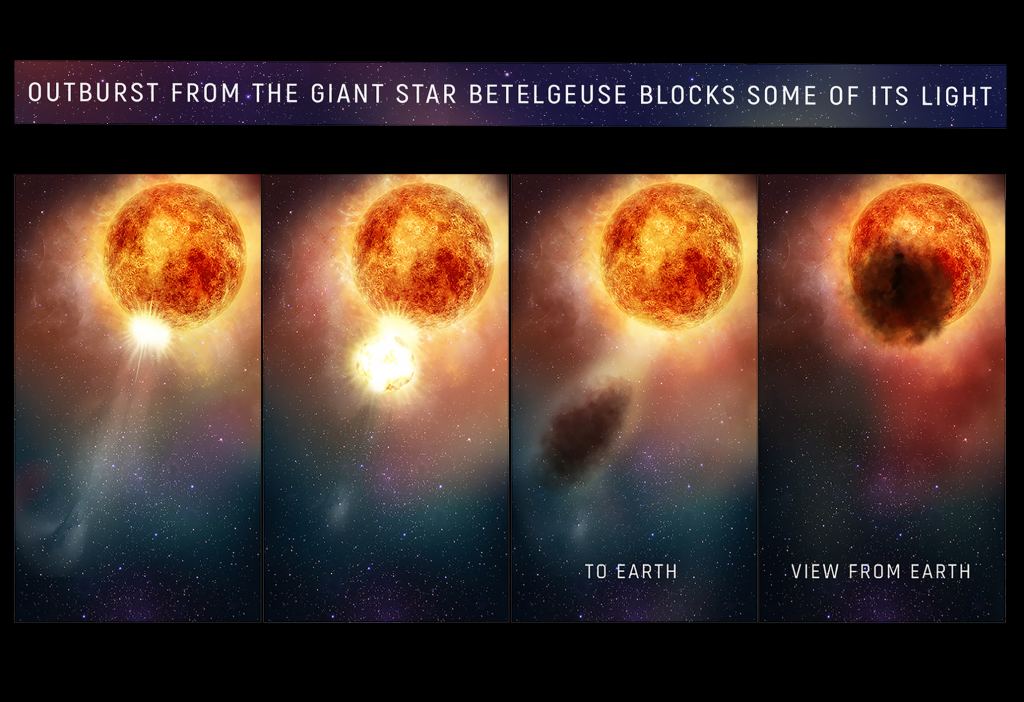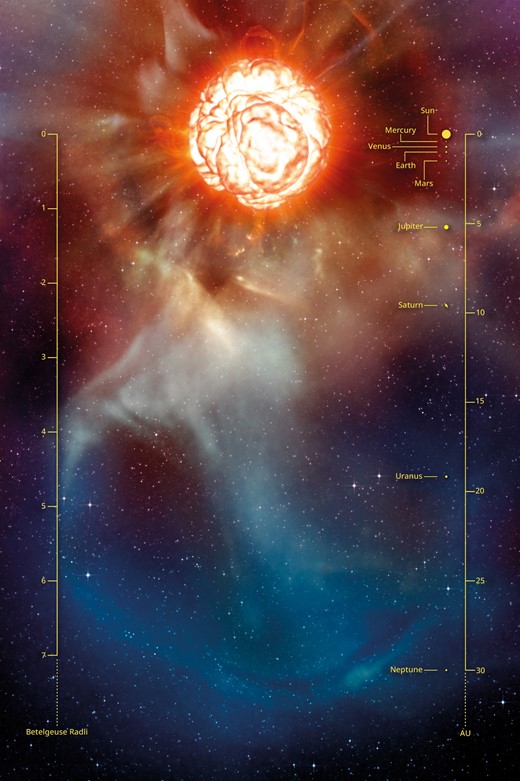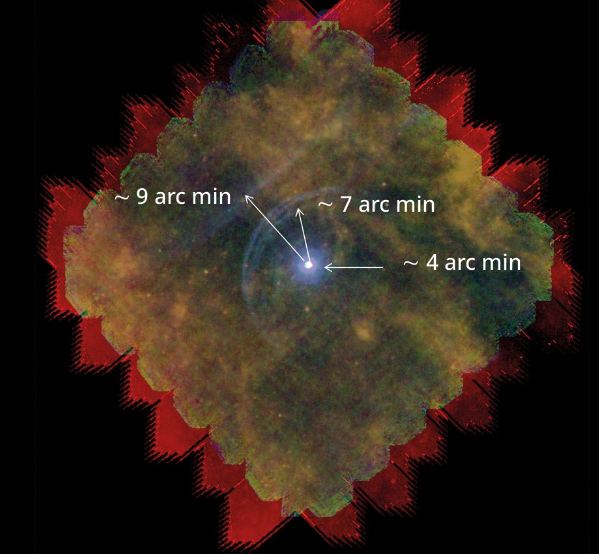Whenever something happens with Betelgeuse, speculations about it exploding as a supernova proliferate. It would be cool if it did. We’re far enough away to suffer no consequences, so it’s fun to imagine the sky lighting up like that for months.
Now the red supergiant star has brightened by almost 50%, and that has the speculation ramping up again.
Betelgeuse will explode as a supernova. On that, there is universal agreement. But the question of when is less certain. The star’s behaviour is confounding. How can puny humans find out?
Betelgeuse isn’t only a red supergiant, it’s also a pulsating semiregular variable star. That means there’s some periodicity in its brightness changes, though the amplitudes can vary. It has an approximately 400-day cycle where its brightness changes. It also has a shorter 125-day cycle, another 230-day cycle, and a whopping 2200-day cycle, all determined by pulsations. All those cycles can make the star difficult to understand clearly.
A couple of years ago, Betelgeuse dimmed, and people wondered what that meant. It turns out that the star’s brightness didn’t actually change. Instead, the star had ejected material from its surface that cooled into a dust cloud and blocked the light. The episode is called ‘The Great Dimming.’

This graphic shows what likely caused Betelgeuse to become dimmer for a time in 2019. Credit: NASA, ESA, and E. Wheatley (STScI)
Now that it’s brightening, it’s attracting scientists’ attention again. They want to know what evolutionary stage it’s in and what all this activity signifies. New research shows that it could explode as a supernova sooner than anyone expected.
The new paper is “The evolutionary stage of Betelgeuse inferred from its pulsation periods.” The first author is Hideyuki Saio from the Astronomical Institute, Graduate School of Science, at Tohoku University in Japan. The Monthly Notices of the Royal Astronomy Society has accepted the paper for publication.
The juiciest parts of new research often grab the headlines. No sense railing against that. That’s how humanity rolls.
We’re not picking on Dr. Eldridge. She’s not wrong. It’s just that the paper says that’s only one possible outcome. It outlines several others.
In their paper, the authors say that Betelgeuse could be the Milky Way’s next supernova, regardless of which of their outcomes might prove to be true. “We conclude that Betelgeuse is in the late stage of core carbon burning, and a good candidate for the next Galactic supernova,” they write.
As a red supergiant, Betelgeuse has left the main sequence. Throughout its long 8 to 8.5 million-year history, it used up vast quantities of hydrogen by fusing it into helium and releasing the lost mass from that fusion as energy. (Thanks Einstein.) That means it’s not fusing hydrogen into helium anymore like the Sun is. When stars like Betelgeuse lose mass, their gravity can no longer contain their outward pressure, and they expand into a more voluminous envelope. So despite losing mass, they grow in size.

This schematic shows the scale of the red supergiant Betelgeuse and its circumstellar medium compared to that of the Solar System. Image Credit: L. Calçada, European Southern Observatory (ESO)
After stars like Betelgeuse leave the main sequence and no longer fuse hydrogen into helium in their cores, things change dramatically. During the helium fusion stage that follows, carbon builds up in their cores. Then they begin a core carbon-burning period that produces other elements. The authors of the new paper say that Betelgeuse is in the late stages of that period.
But how late? How much time is left? There’s no exact answer for that yet.
“Despite the relatively small distance from Earth, and in some sense because of it, it has been difficult to obtain tight constraints on the distance, luminosity, radius, current and Zero Age Main Sequence (ZAMS) masses, and information about the internal rotational state and associated mixing and hence on the evolutionary state of Betelgeuse and when it might explode,” write the authors of a new review of Betelgeuse. ZAMS is particularly critical to understanding the evolutionary stage of particular stars. It’s fundamental, though not solely responsible.
But the study presents some solid possibilities.
The work is a combination of observations and models that each suit the observations in different ways. It’s a tricky business, which is why headlines or Tweets claiming it could explode in tens of years are a little misleading. Nuance seldom attracts attention.
The core carbon-burning period has several stages. The difficulty in determining when Betelgeuse will go supernova comes partly from determining which of those stages it’s in. Betelgeuse pulses, ejects material, rotates, and on top of that, is a runaway star speeding through space. Its distance from us is also subject to debate. “Although it lies only ~200 parsecs from Earth, and hence can be spatially resolved with appropriate instrumentation, uncertainties in its distance remain a critical impediment to deeper understanding,” the Betelgeuse review explains.

This image is based on data from the Herschel mission and shows the circumstellar medium (CSM) surrounding Betelgeuse as it speeds through space. There’s a prominent bow shock at 7 arc min, evidence of its movement. There’s also another feature in the CSM at 9 arc minutes that could be evidence of a past merger or material expulsion from Betelgeuse. Betelgeuse is complex and difficult to understand. Image Credit: Decin et al. 2012.
What’s attracted everyone’s attention is these two sentences from the research: “According to this figure, the core will collapse in a few tens years after the carbon exhaustion. This indicates Betelgeuse to be a very good candidate for the next Galactic supernova, which occurs very near to us.”
This is the figure they’re talking about.

This figure from the study shows the abundance of different elements in Betelgeuse. Elemental abundances are like a fingerprint or snapshot of what’s happening inside the core, what stage of carbon-burning the star’s in, and when it will explode. Fusion products from the core are periodically dredged up from the core to the surface by convection, giving researchers a glimpse into the core. But nailing down when it’ll explode also depends on knowing the star’s initial mass, how quickly it’s rotating, and a host of other factors, all of which are difficult to determine to varying degrees. Image Credit: Saio et al. 2023.
But what hasn’t attracted as much attention is the following part of the paper.
“In fact, it is not possible to determine the exact evolutionary stage, because surface conditions hardly change in the late stage close to the carbon exhaustion and beyond,” the researchers write. Astronomers can only see the surface, but it’s what’s happening deep inside the star that tells the tale.
The authors of the paper are really saying that according to observations, data, and modelling, Betelgeuse could explode sooner than thought. But—and this is critical—they don’t know what stage of core carbon-burning the star’s in. Carbon burning could go on for a long time, according to some of the models that fit the data.
But not everyone agrees that Betelgeuse is even in the core carbon-burning stage. The authors of the Betelgeuse review say that the star is still in the helium phase. “Since core helium burning is far longer than subsequent burning phases, Betelgeuse is most likely in core helium burning. The pulsation period likely constrains the radius and distance and the evolutionary state to core helium burning,” they write, while acknowledging that there are “arguments to the contrary.”
Another way the researchers tried to determine the timing of Betelgeuse’s supernova explosion is by matching its periodic pulsations with models of the same. That’s what Jonathan McDowell is referring to in the above Tweet.

This figure from the research presents four models that match Betelgeuse’s (alpha Ori) four cycles or periods. If you’re not an astrophysicist, it’s confusing. (I’m not one, and I’m confused.) But it does help illustrate the complexity behind predicting Betelgeuse’s explosion, and the uncertainty. Image Credit: Saio et al. 2023.
When it finally explodes—and nobody disagrees with its eventual explosion as a supernova—it’s not likely to produce a deadly gamma-ray burst as some supernovae do. And while it will eject material and produce powerful X-ray and UV radiation, we’re too far away to be affected. Instead, it’ll be a light show visible to the entirety of humanity, and that will change the Orion constellation forever. Scientists say it’ll probably leave behind a neutron star, maybe a pulsar that will be visible for millions of years. The entire event, from start to finish, will be an unprecedented opportunity to study stellar evolution, supernovae, and stellar remnants. Scientists will be able to work backwards from the explosion to all the research done and all the observations and data and pinpoint where they were correct and where they were wrong. Old Betelgeuse will teach them a lot.
The shock wave from the supernova will arrive in about 100,000 years and will be easily deflected by our Sun’s solar magnetosphere. The biggest effect on Earth will be an increase in cosmic rays striking our upper atmosphere.
Most of us will behold this calamitous explosion and sit in rapt awe of nature’s power, we hope, while others will degenerate into weird conspiracy theories or quasi-religious, pseudo-scientific, cult-like reverence.
If, that is, humanity is still around when the blessed event occurs.





